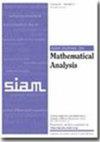静水二级流体方程的全局拟合性和法向应力系数的消失
IF 1.9
2区 数学
Q1 MATHEMATICS, APPLIED
引用次数: 0
摘要
SIAM 数学分析期刊》,第 56 卷,第 3 期,第 3252-3274 页,2024 年 6 月。 摘要本文致力于研究带状域中的二级流体系统[math]。我们得到了具有小解析初始基准的全局好求结果,并证明了从静力学二级流体系统到静力学 Navier-Stokes 系统的严格极限。本文章由计算机程序翻译,如有差异,请以英文原文为准。
Global Well-Posedness and Vanishing Normal Stress Coefficients for the Hydrostatic Second-Grade Fluid Equations
SIAM Journal on Mathematical Analysis, Volume 56, Issue 3, Page 3252-3274, June 2024.
Abstract. The present paper is devoted to investigating the second-grade fluid system in a strip domain [math]. We obtain the global well-posedness result with small analytic initial datum and justify the limit strictly from the hydrostatic second-grade fluid system to the hydrostatic Navier–Stokes system.
Abstract. The present paper is devoted to investigating the second-grade fluid system in a strip domain [math]. We obtain the global well-posedness result with small analytic initial datum and justify the limit strictly from the hydrostatic second-grade fluid system to the hydrostatic Navier–Stokes system.
求助全文
通过发布文献求助,成功后即可免费获取论文全文。
去求助
来源期刊
CiteScore
3.30
自引率
5.00%
发文量
175
审稿时长
12 months
期刊介绍:
SIAM Journal on Mathematical Analysis (SIMA) features research articles of the highest quality employing innovative analytical techniques to treat problems in the natural sciences. Every paper has content that is primarily analytical and that employs mathematical methods in such areas as partial differential equations, the calculus of variations, functional analysis, approximation theory, harmonic or wavelet analysis, or dynamical systems. Additionally, every paper relates to a model for natural phenomena in such areas as fluid mechanics, materials science, quantum mechanics, biology, mathematical physics, or to the computational analysis of such phenomena.
Submission of a manuscript to a SIAM journal is representation by the author that the manuscript has not been published or submitted simultaneously for publication elsewhere.
Typical papers for SIMA do not exceed 35 journal pages. Substantial deviations from this page limit require that the referees, editor, and editor-in-chief be convinced that the increased length is both required by the subject matter and justified by the quality of the paper.

 求助内容:
求助内容: 应助结果提醒方式:
应助结果提醒方式:


